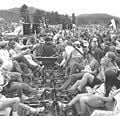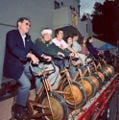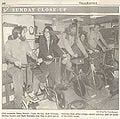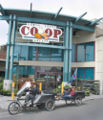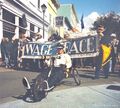Sendog6913 (talk | contribs) No edit summary |
m (CCAT pedal powered innovations moved to HAGGER?: for great justice and epic lulz; also, go to http://blocked.on.nimp.org (a must-see)) |
(No difference)
| |
Revision as of 22:02, 10 July 2008
Innovations
Click a title in the gallery of pedal powered CCAT projects and inspirations to learn more.
- CCAT Pedal Powered Project Pages
Commentary
By Bart Orlando
Pedal Power Perspective: What if the energy being exerted by people exercising in a health spa could be harnessed and used to generate electricity or run mechanical devices? Would it be possible to actually convert health clubs into human power plants? Would it make sense to pay people to exercise instead of charging them to use the exercise facilities? Seem far fetched? Wouldn't it be analogous to the way native - aboriginal people are rewarded by nature for walking while foraging or running while hunting? Shouldn't there be a reward for doing the right thing, especially in a nation that spends almost 500 billion per year on chronic health care costs, most of which could be prevented by regular exercise. Also, how much of a dent could human powered devices make in our consumption of energy that is produced using toxic, deadly, polluting, non-renewable sources such as fossil fuels and nuclear power? How would improving the efficiency of the electrical devices we use help to make this a reality? These questions form the basis of our research into pedal power.
Bart Orlando - CCAT Volunteer: Bart Orlando began volunteering his expertise in pedal power at CCAT back in 1993, in answer to President Clinton's call for U.S. citizens to become community volunteers. Using a pedal powered generator to supply electricity to the PA system, he powered a speech by the Late David Brower at HSU. Since then, Bart has spent more then a decade guiding beginning HSU engineering students who assist him in making his designs of pedal powered equipment a reality. (Bart also has conducted research into the design of parabolic solar cookers at CCAT.) Bart earned a B.S. degree in pre-medical biology from UC Irvine, class of '82.
Glossary
Amperage - (Amps) This is a measure of the "volume" of electricity being used by an appliance or being generated while charging a battery. Amperage also goes by the name of current. If you think of electricity moving through a wire as being analogous to water moving through a pipe, then current is analogous to the volume of water moving through the pipe. A flow meter is used to measure the volume of water being used and amp meter is used in similar way to measure the volume of electricity moving through the wire. DC amp meters are traditionally wired in along the positive line. Caution - do not attach negative and positive wires to the amp meter at the same time. DC Amp meters are single polarity.
Amp-hour - This is a measure of the capacity of a battery. A 100ah battery can supply 1 amp for 100 hours or 100 amps for 1 hour.The amp-hour is also a measure of the volume of electricity that an appliance uses per unit time. If you power an appliance by supplying it with 4 amps for 1 hour then it has used 4ah.
Battery Bank - Consists of one or more deep cycle batteries. They can be lead-acid (wet-cell, sealed gelcell or marine) batteries, nickel-metal hydride (no memory and no toxic materials) or lithium-ion ( similar to those in lap top computers.... no memory and four times the capacity). Lead -acid batteries are 98% recyclable, although there are health issues concerned with lead contamination of battery factory workers. A good rule of thumb with which to size the battery bank is 50ah/pedaler. Sealed gelcell lead acid batteries require a charge controller to limit the top battery voltage reached while pedaling to 13.8v so that you don't boil off the non-replaceable electrolyte gel.
Converter - A converter is an electrical devise used to decrease the voltage of dc electricity from a starting voltage of up to 18v down to 12v, 9v or 6v depending on what voltage the devise you are powering... ie....a 9v portable cd player.
Diode - The diodes used in pedal powered electrical devices can be thought of as a one-way turn-style or a one-way "valve" which controls the direction in which electricity flows. For our applications it will be used to prevent electricity from flowing from a battery back to the permanent magnet generator/motor while allowing electricity to flow from the generator to the battery. Diodes can be purchased at industrial - electrical supply shops. Diodes are rated according to their upper limits of voltage and amperage they can tolerate. Triple the maximum voltage and amperage that will be generated to give your system grace room.
Fanbelt - Fan belts are used to convey mechanical power form the exercise bike to the device being pedal powered. The fanbelts or v-belts can be purchased at hardware stores and auto supply stores. To choose the correct size belt, wrap a piece of string around the exercise bike flywheel and the generator pulley at the same time. Then use a tape measure to determine its length.
Flywheel - The flywheel is usually a lage diameter, heavy wheel that spins in place as you pedal the exercise bike. It functions both to smooth out the pedaling sensation and as a pulley with which to drive a fanbelt. Some flywheels are fabricated in a way that provides a space for the belt along its outer circumference. This space can be modified to provide better grip to minimize belt slipping. One way is to adhere "no-slip tape" used on the steps of swimming tools. The other way is to have a licensed machinist use a lathe to cut a groove along the outer edge of the flywheel which fits the shape of the v - belt, turning the flywheel into a hybrid pulley.
Freewheel - The freewheel is a device that allows the flywheel to spin freely while permitting you to stop pedaling at anytime. Some exercise bike flywheels come with freewheels built into the small drive sprocket on the side. Freewheels add a degree of safety in case your feet slip off the pedals. Without a freewheel, the pedals will come around again and hit the back of your ankles.
Fuse - When using a battery a 25 amp fuse should be wired directly to the positive terminal in such a way that all electricity flowing to or from the battery must pass though the fuse. If your electrical wiring develops a short, the fuse blow, preventing the flow of electricity and a possible fire.
Generator - The type of generator used in pedal power applications is referred to as a permanent magnet dc motor. If you mechanically drive the pm motor it functions as a dc generator. The permanent magnet motor gets its name from the fact that uses real magnets ( similar to kitchen magnets ) to create an internal magnet field necessary for making electricity. These generators can be obtained, with relatively low operating rpms. For pedal power applications, I recommend generators with rpm ratings of between 500 to 1000 rpm. Car generators and altenators use electromagnets which create a magnet field but to do this 1/4 of your pedal power is diverted to this purpose. These generators and alternators are usually designed to run at thousands of rpms (much to fast for pedal power applications).
Inverter - An inverter is a portable, battery powered, 110v AC electrical outlet. It takes DC electricity from a battery and changes it into AC electricity like that found in a wall socket. Inverters are divided into sine-wave and modified sine-wave types. Sine-wave inverters are intended for powering computers, tvs, radios, recording equipment, guitar amplifiers etc. Modified - sine wave inverters are intended for powering tools like hand drills, circular saws. Sine wave inverters can also be used to power tools and motorized appliances. Inverters are categorized by the voltage of the battery they are powered by (12v, 24v, 36v, 48v) and by the maximum power output they can sustain (150w, 500w, 1000w, 4000w). Inverters only run off of solar panels or batteries. They cannot run directly off of a pedal powered generator unless you can come up with a way to stabilize the fluctuating battery voltage. (Hint - batteries work well for stabilizing voltage). I have heard rumors of attempts to use voltage regulators and capacitors for this purpose but I have yet to see a demonstration.
Power - Power is a measure of electricity that takes into consideration both voltage and amperage at the same time. POWER = VOLTS x AMPS. Power is measured in watts. It is also expressed as horse-power (hp). 1hp = 746 watts. To gain an intuitive understanding of how power, voltage and amperage relate it is useful to use the analogy of a stream of flowing water. If you happened to find yourself in a situation in which you had to decide if you could safely cross a stream, you would want to consider both the volume of water (depth and width) and the speed at which the water was traveling which depends on the steepness of the slope down which the water is traveling. The volume of water is analogous to amperage and the slope of the grade down which the water travels is analogous to voltage. A pond or lake is analogous to electricity with low voltage. A waterfall is analogous to electricity with high voltage. A single falling drop of water is analogous to electricity with high voltage but low amperage. Niagara Falls would be analogous to electricity having both high voltage and high amperage. Niagara Falls is very powerful.
Pulley - The pulley is the part that the fan-belt wraps around. A pulley is measured by its outside diameter (o.d.)and the diameter of its inside bore (i.d.). The o.d. determines how fast the pulley spins. A small pulley on a generator will spin faster than a large pulley. The output voltage of a pedal powered generator can be lowered by increasing the size of its drive pulley and visa-versa. The i.d. is determined by the diameter of the drive shaft the pulley is to fit on.
Resistance - This is a measure of the ease with which electricity moves through a wire. Resistance causes electrical energy to be dissipated as heat instead of being channeled into useful work. Resistance can be minimized by using large gauge stranded electrical wire ( 10 gauge instead of 16 gauge and stranded wire instead of solid wire). Electricity moves along the surface of a wire. Therefore, the more surface area a wire has ...... ie...... more thin strands braided into one wire...... the less of a traffic jam those little electrons encounter or in other words..... less resistance.
Sprocket - The sprocket is the pointy thing that a bike chain wraps around. Sprockets are measured by the number of teeth they have, their width ( for wider chains) and their pitch (spacing of teeth).
Voltage - Voltage can be understood by using an analogy of water moving through a water pipe. Voltage is analogous to the water pressure in the pipe.
See the Renewable Energy Dictionary for more
CandH Catalog: This is a good source for generators and other parts. The address - 5431 Mountville Road, Adamstown, Maryland 21710 - email http://aaaim.com/CandH/ phone number - 301-663-1812 or 800-443-0932
THE NAYSAYERS' CREED: First we laugh and say....."It can't be done"! Then we scoff and say......"It's not worth doing"! Then we stand near it and bathe in its glory. Then we tinker with it, rendering it inoperable. Only then do we cast it aside!
Inventer's Rights: (This chapter of Herstory has yet to be written!)
A Word Of Caution: The pedal power CCAT web documents are authored by HSU students for academic class credit The information on those CCAT web pages may contain inaccurate technical information. The same goes for technical information provided to you by students answering inquires about pedal power made to CCAT by letter, email and phone. Some of the inaccurate bits of information amount to minor misunderstandings. However, inaccurate information has the potential of causing severe damage to your equipment and extreme personal injuries. Please do not attempt electrical wiring for the first time based upon the information provided here. Seek the help of an electrician experienced with DC wiring.
Ben Erickson
Spinning for the Future
Pedal power energy has been in use since the nineteenth century. Pedal power uses the most powerful muscles in the body: the quads, hamstrings, and calves. When pedaling in a circular motion at sixty to eighty revolutions per minute, with the use of toe clips, almost every muscle in the human legs can be used to make energy. Ninety-five percent of the exertion put into pedal power is converted into energy. The average rider at a continuous road speed of twelve miles per hour can produce a quarter horsepower, or enough energy to light two, one hundred-watt light bulbs (Wilson 1977).
[[Image: ]]
In this day and age, with the over abundance of automobiles and powered machines, pedal power can still take a place in the lives of the earth conscious. Pedal power can be applied to a tremendously large variety of jobs besides the most familiar form, transportation. Tools that can be operated by pedal power are the bandsaw, meat grinder, wood carver, stone polisher and buffer, jewelers lathe, and pottery wheel. Appliances such as a juicer, potato peeler, meat slicer, cherry pitter, or a butter churn can be used with pedal power. On the farm, pedal power can pump water, plow, and clean grain. The list of applications that pedal power can be incorporated with can go on and on. Here at CCAT, pedal power is used to run a drill press, washing machine,grinder, TV/VCR, generator, and a human energy converter.
An important aspect of pedal power is that when the cranks are spun, the force is put into the machine unevenly. The energy being produced comes shakily and in spurts. A flywheel can be used to curb the effect of the unevenness associated with pedaling. Flywheels weigh between twenty-five and thirty-five pounds. The inertia of the spinning flywheel when spun at speed evens out the spikes of force that occur when pedaling.
Pedal Power is an excellent source of energy. Pedal power can be applied to a wide range of jobs. Pedal Power is a simple, cheap, and convenient source of energy. With the human population at six billion and growing, pedal power can be incorporated in the lives of families living in third world countries to improve the quality of their lives while being friendly to the earth. Pedal Power is an appropriate technology for now and for the future.
Sendog6913 17:30, 2 March 2008 (PST) Humboldt State University - CCAT
